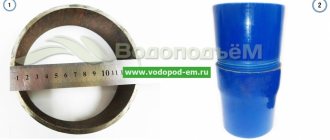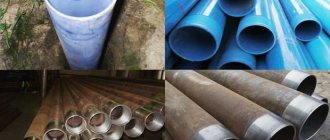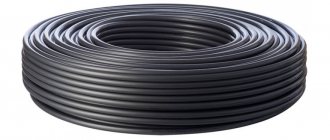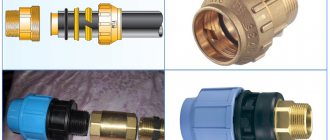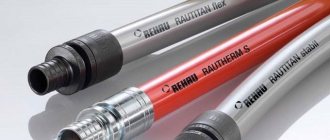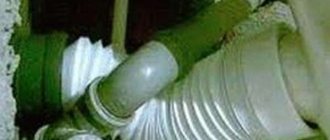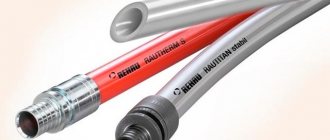There are many options: steel - seamless, seam, galvanized. Different grades of steel, different diameters and wall thicknesses.
Plastic HDPE (low density polyethylene) and uPVC (unplasticized polyvinyl chloride).
Which ones to choose? Depends on how much you are willing to pay. The most durable are seamless steel pipes 20 with a wall thickness of 5.0 mm, they last up to 50 years, but they are the most expensive. In the current economic situation, everyone is looking for cheaper options, mainly by reducing wall thickness.
Attention: sometimes, as a marketing ploy, they use the cheapest pipes, prohibited for drilling, 3.5 mm thick with welded tips 10 cm long from normal pipes at the joints, calling them reinforced. And you will notice that the casing is rotten when the short warranty period ends. In this situation, for those who like to save endlessly, we can recommend a foil casing.
Casing pipes - facts and legends
When looking for a contractor to drill a well, the client is faced with a difficult situation. Typically, companies offer casing pipes of different types, and the column models are reasonably declared to be the best for your case. The customer needs to take into account that if the drilling company sells one type of casing, then it will actively advertise their advantages. But you need to choose what will line the pit based on the requirements for the water supply system, and not from several characteristics. Which casing pipe is best to use for a well depends on the depth of the pit, quality, type of water intake, and the budget planned for water supply.
How to introduce water into a house from a well - HDPE pipe thickness
Taking into account average and peak water consumption for a country house, the optimal diameter is 32 mm, providing sufficient throughput
I always make an individual calculation for each individual customer, and the calculations are based on the following indicators:
- Total number of consumers - number of people living in the house
- Total number of water intake points and their maximum peak consumption
- Loss of throughput in the water treatment area - filtration systems
- Supply pipe length (the longer, the larger diameter required)
- Reserve for the possibility of connecting additional water consumption points later
- Type of pumping equipment
As a result, I get the value of peak water consumption, provided that all plumbing fixtures and equipment are turned on simultaneously. For all of them to work correctly, the pipe must provide a throughput greater than this value.
Water pipe – diameter 32 mm.
The throughput of a pipe depends on its internal diameter. Let me give you a few meanings so you can get your bearings:
- 25 mm – 750 liters per hour
- 32 mm – 1620 liters per hour
- 40 mm – 2500 liters per hour
- 50 mm – 4700 liters per hour
I don’t see any point in giving values for pipes of larger diameter, because the flow rate of domestic wells rarely exceeds 5 tons per hour, and consumption in a private home is much less. The optimal diameter of the supply pipe is 40-50 mm.
How to choose the right casing pipe?
First, let’s clarify what a well is and what role the casing plays in it. A well is a working, a cylindrical channel made with a drilling tool in the ground, and the diameter is much less than the depth. To organize an autonomous water supply, vertical pits are drilled with a depth of several meters to several hundred meters. To prevent the walls of the excavation from collapsing, and contaminated water from the surface, from the intermediate layers, from getting into the water intake zone to the pump, and from there into your taps, the pit is strengthened (lined) with columns along the entire length.
A casing column, made up of several pipes, completely separates the soil walls of the pit from the water coming from the aquifer. Depending on the design, plastic profiles can be installed inside - a production column through which water rises to the pump. Without additional plastic profiles, the casing plays the role of the production string.
What types of production pipes should be used in a well to ensure high-quality water supply. More on this below.
Adviсe
When choosing the best casing for a well, be guided by the classic combination of price and quality. These parameters should be determined by the durability of the structure. The optimal combination can only be obtained if you choose the right type of well. There can be two options: artesian or up to the first layer.
There are many more design algorithms. It is better to make deep wells with metal parts with internal and external threads. Wells with a depth of less than 55 cm can be lined with plastic elements with the same thread.
To determine the pipe diameter, consider the following indicators:
- dimensions of the submersible pump planned for use;
- Wall thickness;
- the required minimum gap between the casing and the pump;
- In the case of using pipes with internal threads, the thickness of the nipples must also be taken into account.
The single-column casing is fixed in the ground due to natural friction. Therefore, the pipe caliber must necessarily be larger than the diameter of the penetration.
The two-column element is secured using clamps, which act as centering clamps. In this case, the annulus space must be filled with gravel or crushed stone along its entire height.
When installing a single-column casing, you should keep in mind that it is not possible to pull it back out. In a two-column scheme, the casing pipes are pulled out with a jack using a massive clamp. The silted casing can be cleaned, and the work can easily be done with your own hands with the pump pulled out.
See the next video for more details.
Well casing pipes
There are three types of casing pipes for wells:
- steel;
- plastic;
- asbestos-cement.
The correct type of casing protects the pit from damage. It protects water from contamination, precipitation, and melted snow. Each type has its own version. Steel pipes - stainless steel, black steel, galvanized, enameled steel. Plastic pipes - HDPE (low-density polyethylene), uPVC (unplasticized polyvinyl chloride), PP (polypropylene).
The ongoing debate about the superiority of one type over all others is meaningless. Each column, for example, strong steel 20 or relatively soft HDPE plastic, is suitable for specific conditions, taking into account depth, well diameter, soil parameters, duration, seasonality, etc. The choice is complicated by popular stereotypes, legends (both laudatory and negative) about the quality of materials, as well as the desire of the contractor company to benefit rather than provide maximum reliability. The coupling connection of casing pipes ottm d with a trapezoidal profile thread is used for the construction and operation of vertical wells in oil and gas fields. Couplingless casing pipes have a threaded connection made within the dimensions of the wall. The connection design provides clearances along the outer and inner diameters. Non-retrievable casing cannot be removed. It can only be plugged together with the foundation pit.
seamless stainless steel pipe - reliable, but expensive
The first step in choosing a casing is to determine the type (sand or limestone) and depth of the aquifer. There are no accurate maps that will predict the depth of the well on your site with an accuracy of up to a meter. But an approximate figure can be found from neighbors who have already drilled, or from a drilling company using summary tables of previous drilling in the area. Having found out the possible depth of the future well, you need to find out the characteristics of the geological layers that will have to be drilled, whether there are quicksand and intermediate aquifers.
Peculiarities
The selected well casing must meet certain requirements. For example, the standard for metal pipes is GOST 632-80.
The state standard for asbestos-cement pipes is 539-80. The regulatory document that mentions the parameters of plastic pipes is GOST 2248-001-84300500-2009. The choice of pipes from this material is complicated by the fact that, in addition to GOST, there are many types of specifications.
In addition, there are numerous foreign standards. When choosing a particular type of casing pipe, knowledge of the advantages and disadvantages is important. Therefore, it is worth understanding the characteristic features in more detail.
The main advantages of metal products:
- high strength;
- the presence of a thread that allows you to create a sealed structure;
- service life up to 50 years;
- Possibility of cleaning when silting occurs.
Among the disadvantages of metal casing pipes it is worth noting:
- susceptibility to corrosion;
- rusty sediment in the water;
- significant weight of structures, which complicates installation;
- high cost of products.
Asbestos-cement casing pipes have the following qualities:
- resistant to aggressive salts;
- they are resistant to corrosion;
- safe and practical to use;
- have a long service life.
In addition to the advantages, asbestos-cement lining also has disadvantages:
- complexity of installation - you need to use expensive lifting equipment;
- fragility of products;
- lack of thread, as a result of which the elements are fixed end-to-end;
- difficulty in maintenance: cleaning of products is complicated due to high porosity; in addition, work related to cleaning cannot be carried out without completely draining the well.
The most significant disadvantages are low mechanical strength and inability to withstand dynamic loads. An important point is that it is not advisable to choose plastic pipes for deep wells. Operating conditions for wells with PVC pipes should be gentle.
Casing pipe requirements
Autonomous water supply for a country house lasts for a long time. Therefore, the casing must ensure several very important conditions: the integrity of the wellbore during movements and soil pressure, the tightness of the column, and the absence of a negative effect on water.
The pipe for the well on the site is selected according to a number of criteria:
- quality and type of soil layer;
- water intake dimensions;
- burial depth;
- drilling method.
It is obvious even to a non-specialist that steel casing meets all of the above requirements. Why is there debate about choosing the best column? There is only one reason for the controversy - price. Steel will always be more expensive than other materials. Therefore, in order to attract customers, drilling companies offer various cheaper options - made of plastic, asbestos cement, thin galvanized or enameled metal, etc.
The main argument for choosing a non-steel column is considerations of savings. Reasonable savings are necessary, but one must realistically evaluate the capabilities of non-metallic materials when working in difficult conditions deep underground, otherwise you can make a mistake and save on the reliability and durability of the well.
Is a well conductor really needed - in what cases?
A conductor may be required in areas with loose soils and deep cracks, but I advise you to be careful if drillers insist on using it - for the Moscow region this measure can be considered an extreme measure.
First, I will explain what a well conductor is. Essentially, it is a pipe of larger diameter compared to the casing itself. Its use is not always necessary - sometimes drillers recommend its use in order to earn more, because the price of one linear meter of drilling in a section with a conductor increases by about 1300-1500 rubles.
But sometimes you really can’t do without it - however, this becomes clear in 90% of cases after the drilling has started.
Construction of a well with a conductor.
The use of a conductor in the Moscow region is necessary when the upper soils are loose or have deep cracks.
Drilling is carried out by supplying an aqueous solution to the drill head, and if there is a crack in a section of the wellbore, the solution begins to leak out, but dry drilling cannot be done. In this case, the conductor will indeed be the only way to continue work and reach the specified depth.
IMPORTANT
The conductor does not need to be driven to the entire depth of the well - it is enough to go through the problem area in the upper layers of the soil, after which drilling continues without it. Additional payment is made according to the footage of the additional pipe. The space between the conductor and the column must be sealed with concrete pouring.
Steel casing pipe: time-tested!
Wells have been lined with steel profiles for a very long time—decades. Over the past time, they have passed all possible tests with honor in shallow and very deep wells, in soils of all types, confirming their reliability. Soil movements, external pressure of rock and individual stones are not a problem for the steel profile. The service life of a black steel column is 40-50 years. This period is determined by the rate of wall corrosion - 0.1 mm per year. At the same time, a small amount of rust getting into the water is not critical, especially if the water is used regularly.
classic casing pipe - steel 20, service life - 40-50 years
It is appropriate to remember here that the city water supply network also uses black steel casings. Iron comes into artesian water from limestone or other rock! If it were otherwise, then none of the wells lined with plastic or asbestos cement would have had an iron removal filter installed.
The strength of steel profiles allows you to carry out any repair work or well cleaning without fear. The high cost of steel allows shallow sand wells to be lined with durable thick-walled plastic. But for an artesian well there is no alternative to steel. The great depth of aquiferous limestone and long periods of well use require the use of the most reliable materials for casing.
Asbestos cement pipe products
Also, the casing can be equipped with asbestos-cement pipe products, and they can easily replace steel products with good material benefits. But asbestos cement has some special properties that should be taken into account when installing the casing.
Among the important characteristics of asbestos cement pipes are the following:
- The material meets environmental requirements and is neutral towards chemicals. These properties of the material indicate that during operation the possibility of harmful elements entering the water is eliminated.
- There is an opinion that asbestos has carcinogenic properties, but it has no justification. Yes, there may be fibers of the material in the water, but in small quantities, which can be easily removed using household water filtering devices.
- Asbestos cement is fragile, therefore, it requires caution during installation and operation. In addition, it is not recommended to carry out additional drilling of a finished well, the casing of which is made of asbestos cement.
- Asbestos-cement pipe products have fairly thick walls, which requires drilling larger wells to install such products.
- A pipe for the manufacture of which asbestos cement was used cannot be used as a filtration column in sand wells, therefore they are used only in artesian wells.
- The physical properties of the material allow the use of pipes in wells up to 100 meters.
Steel Casing Options
Stainless steel - to all the advantages of black steel there is added a complete absence of corrosion, but, unfortunately, a very high price. Stainless casing will not provide a radical improvement in water quality. As we have already said, almost all rust gets into the water from the host rock. It is known that black steel allows a well to operate for several decades. Is it worth paying more and extending this period? During this time, something may happen to the water-bearing horizon itself or the living conditions on the site.
galvanized thin wall steel pipes
Galvanized steel - in addition to the harm to health from zinc compounds entering the water, the life of the well is reduced. The fact is that galvanizing is designed to reduce the rate of corrosion of a thin-walled steel column. The wall thickness of a galvanized column is 2.5-3 mm, compared to 4.0-4.5 mm for an ordinary black steel column. During the casing process, scratches and chips inevitably appear on the zinc coating, which become the point where corrosion begins. The threads on the ends also do not have a zinc coating.
enameled steel pipes
Enameled steel casing is an extremely fragile coating and it is almost impossible to avoid damage during casing. The column is also thinner than a regular steel column; the places where the enamel is chipped will be the starting point for corrosion.
Which casing pipe is better in clay soils? – for casing silty soil, it is recommended to install galvanized steel columns.
Galvanized pipe for a well - is it acceptable?
The use of galvanized metal for food purposes is unacceptable - it is not only of little benefit to human health, but is also extremely unreliable.
You will find the answer to this question in your own kitchen - is there a lot of galvanized cookware there that you use for food purposes?
Not at all. I rarely come across wells equipped with galvanized pipes, because no one offers them en masse - these are isolated cases when used galvanized pipes fall into the hands of small companies.
Their true purpose is the construction of pipelines for pumping gas, oil products and water not intended for food use.
Galvanized pipe.
The cost of a new galvanized pipe is higher in comparison with a similar pipe made of ferrous metal, since galvanic treatment requires additional costs.
However, as far as I know, unscrupulous drillers offer it at a lower price when constructing wells, since these are cases of inappropriate use, and the product itself has already been used.
I will highlight several disadvantages of using such pipes:
- Possible harmful effects on water , including in the aquifer itself
- Shorter service life - exposure to stray currents and the resulting electrolytic reactions perforate the casing walls very quickly
- Problems when it comes to certification of hydraulic structures
I advise you to use traditional solutions, because such savings always backfire in the end.
?????????? ???????? ?????? ???????
Asbestos cement casing pipes
Opponents of asbestos-containing materials and their defenders have not yet agreed whether asbestos-cement profiles are harmful to health or not. These casings are very cheap, corrosion resistant, chemically neutral, but quite fragile. Due to fragility, the wall thickness has to be increased, which increases the mass of the product and the diameter of the well during drilling.
asbestos cement pipes
The fragility of asbestos-cement compounds complicates their delivery and does not allow their use in unstable soils and certain types of well cleaning and repair work. To tightly connect the joints, it is necessary to use couplings, which complicates the design and reduces reliability. The maximum casing depth of an asbestos-cement column is no more than 100 m.
Purpose
When drilling wells, a casing is always made of special pipes, which performs the following functions:
- The main purpose of the casing is to protect the mine from soil shedding and clogging of the borehole channel.
- The presence of a column makes it possible for the water column to rise upward without being absorbed into the ground, and prevents water pollution.
- Due to the tightness of the connection of the pipe sections, the casing protects the well source from the penetration of contaminated surface and ground water into its channel.
- It is convenient to immerse a deep-well electric pump that sucks up water into a smooth and rigid round trunk.
- A cap or cover is attached to the top of the column, which prevents external precipitation and dirt from penetrating into the channel and serves as a support for the safety cable of the deep-well electric pump.
- When connecting an adapter water supply, the casing pipe is a support for attaching the adapter, which is cut from the side into its wall at a depth below the freezing point.
- The filter, located at the bottom of the column, filters out large and small particles of gravel, sand, limestone, clay, making the water more suitable for drinking and household needs.
Rice. 2 Designs of casing steel pipes according to GOST 632-80
Plastic casing pipes
Plastic products have only recently been used for casing wells, and there are no complete statistics on their reliability yet. The material for plastic casings can be: HDPE (low-density polyethylene), uPVC (unplasticized polyvinyl chloride), PP (polypropylene). Plastic profiles have many advantages: low price, low weight, facilitating transportation and installation, tightness of the connection. Plastic is resistant to corrosion and chemically inert materials, safe for humans. The weight of a plastic casing pipe is much less than that of asbestos cement or metal. They are easier to install and change if necessary. The main disadvantage of plastic profiles is their low mechanical strength.
uPVC and HDPE pipes
As a result: plastic is suitable for use as a production string inside a steel casing, or at depths of up to 50 m in strong soils. A profile made of HDPE is more often used as a production casing, and a profile made of uPVC with thick walls is used as casing. We remind you that no plastic system, even the thickest one, can withstand the loads that steel can easily withstand.
Areas of application
The products are widely used where qualities such as strength and rigidity of plastic bends are in demand:
- Laying pressure and non-pressure sewerage pipelines.
- Transportation of drinking water and other food liquids.
- Construction of drainage networks.
- Construction of casing columns on water wells.
- Manufacturing of protective equipment for athletes and other areas of human activity.
For well
In well drilling, one of the main problems is ensuring the integrity of the drilling rig and protecting equipment from various external mechanical loads. These problems are successfully solved with the help of casing pipes. Previously, steel and asbestos-cement bends were used for these purposes. Now they are being forced out of the market by cheaper and easier to install plastic pipelines. The most profitable and effective among them are pipes made of unplasticized PVC.
Reliable connection of casing pipes
What type of connection is the most reliable? The requirements are very strict: it is necessary to ensure not only the structural integrity of the casing, but also the tightness of each joint. Even a small hole can cause a decrease in water quality and, over time, failure of the pump and the entire well. The length of steel casing pipes ranges from 2.5 to 12 m. To organize individual country water supply, profiles with a length of about 5 m are mainly used. There are three main connection options: threaded, welding, socket. For asbestos-cement profiles there is only one connection option - a coupling.
The classification of casing pipes depends on the type of connection.
- The threaded connection is the most reliable. The threads of the mating parts fit tightly to each other, providing a strong mechanical connection and a high level of sealing.
- Welding joint - may be leaky due to poor-quality seam. The weld itself is more susceptible to corrosion than other parts of the system. As a result, the service life of the entire casing string is reduced.
- Socket connection - it is impossible to control the condition of each joint. The pipes are held together only by their own weight; there is no rigid mechanical fixation, which reduces the tightness of the entire casing. There is no protection against lateral displacement and, especially, against vertical subsidence.
casing threaded connection options
What type of pipe connection should I choose for the casing? Threaded pipes are a little more expensive, but their installation is faster and easier than welded pipes. The strength, tightness and durability of the threaded connection are recognized as the highest.
The strength of casing pipes depends on the selected material. The strongest are steel columns. But they have a high price, which often turns off customers. Asbestos-cement columns are cheaper, but they are fragile; lightweight plastic cannot be used at great depths without double casing. You can buy casing pipes in accordance with GOST 632 80.
The use of casing pipes for private objects is a question that should be left to the craftsmen. It is difficult to determine for yourself which casing pipe is better than HDPE or steel for a particular area. Craftsmen take into account several factors at once, including the depth of the pit, the type of water intake, and the frequency of use. The length of the casing pipe for the well should be 10-20 cm higher than the edge of the pit.
Which column assembly option is better?
A set of requirements for casing pipes and technologies for connecting well string segments is reflected in GOST 632-80. The regulations allow the use of different assembly methods.
Based on the joining method, the appropriate type of pipe is selected, so this issue must be resolved at the well design stage.
No. 1 - permanent contact of pipes for welding
Welding provides the most rigid connection of metal pipes. The main advantage of the method is now being questioned by representatives of a number of drilling companies, who focus on the weak points of welding:
- the likelihood of insufficient sealing of the weld;
- the possibility of pipe deflection along the vertical axis, which makes it difficult to install the column in the well;
- insufficient corrosion protection of the seam.
However, with a high level of professionalism of the welder, the listed defects will not occur. Most building structures (bridges, trusses, oil pipelines) are made of steel and, as a rule, they are welded.
Another issue is that high-quality work requires welding equipment and the involvement of a qualified electric welder.
These measures increase the cost of work performed, reducing the profit and competitiveness of the performing organization.
No. 2 - water-lifting channels with threads
When casing a well with rolled metal, 90% of drilling companies use a threaded connection, pointing to GOST standards.
It sounds quite convincing, but managers of organizations often keep silent that the standards are relevant for pipes with a diameter of 146 mm and a wall thickness of at least 6 mm.
The use of threaded technology significantly reduces the service life of the casing.
The use of a threaded connection on plastic lines does not have such disastrous consequences, but, on the contrary, is considered the most reliable. There are several options for joining polymer pipes:
- Nipple. The thread is cut from the inside of plastic pipes. The two elements are connected through a nipple with an external thread. The diameter of the hole does not increase.
- Coupling. There is an external thread at both ends of the pipe. Docking occurs using an overhead coupling, which increases the diameter of the penetration.
- Socket threaded. Segments with threads on the outer and inner surfaces are used - joining is carried out without additional elements.
With socket joints, a slight expansion of the diameter at the joints is permissible.
Materials for making pipes
Pipes used for well construction are produced from:
- metal - can be enameled, galvanized, black steel or stainless steel;
- plastic - divided into categories such as polypropylene, polyethylene and PVC;
- asbestos cement.
Each of these materials has certain pros and cons. The choice of pipe based on the type of raw material used is carried out taking into account the expected service life, water quality and safety, the overall complexity of maintaining the system and other parameters. Previously, wooden pipes were also used for wells, but now this option is used extremely rarely.

